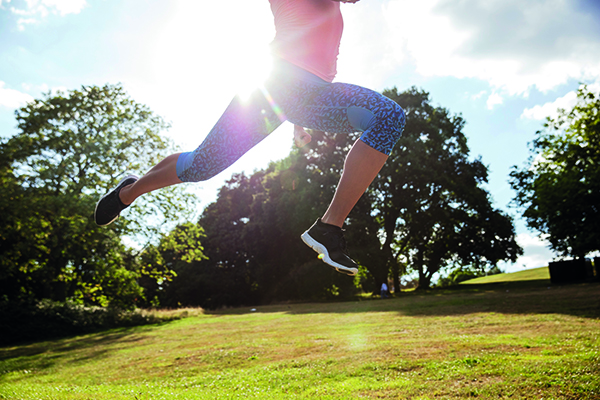It’s not just about the occasional clenching – if you really want to look after your pelvic floor muscles we’ve got five simple ways to do it…
By Katherine Watt
Exercising has many benefits for your body and soul, but it’s not all about toning your arms and tum – sometimes it’s the little muscles you can’t see that will bring you the biggest gains. Yes, we’re talking kegels, elevator lifts, or whatever else you want to call those oh-so-crucial pelvic floor exercises. But, if you find yourself forgetting them more often than not, it might be time to think again. Recent research shows that as well as the obvious result of keeping your bladder and bowels strong, tighter muscles down there improve sexual sensation and orgasm potential – so there’s something to look forward to!
The importance of strengthening this muscle group, which runs from your tailbone to pubic bone, usually comes to the fore after you’ve had children. Then as you head towards menopause, hormones such as oestrogen, which help keep your muscles strong, can wane. But, kegel queen from The Women’s Health Clinic, Laura Spicer, says around 90 per cent of the women she talks to in the clinic aren’t doing the exercises correctly.
‘The trick is to squeeze your internal muscles without sucking your tummy in or clenching your buttocks,’ says Laura. ‘Many people believe this is the muscle group you use when you attempt to stop urinating, and although these are part of the “hammock” of pelvic floor muscles, it is by no means the complete group. So it’s a bit like only working your legs and ignoring your upper body!’
Once you’ve perfected this, there are other tweaks that you could make to protect those pelvic muscles, but first things first…
Master the muscles

To ensure you’re working your pelvic floor properly, start by completely relaxing the muscles in your thighs, bottom and stomach. Then in turn, squeeze in the muscles at the front, as if you’re trying to stop weeing mid-flow. Then clench further up (as if you were squeezing the length of a tampon), and back around your bottom. Try to identify and even visualise this hammock of muscles when you contract them all together – holding for 2-4 seconds – before completely relaxing for a couple of seconds then repeating, remembering to breathe normally. Nothing above your belly button should tighten, but some tensing of the lower abdominals is normal.
Perfect your posture

The stronger your muscles, the longer you’ll stay healthy – and your posture is part of this. Not only will better posture decrease the load on your pelvis, keeping it stronger, but you’ll be better able to do pelvic floor exercises when you sit, stand and walk correctly too. When standing, keep your spine long and the crown of your head towards the ceiling, but with a natural, inward curve in your lower back. Tuck your chin under slightly so it’s not jutting forward, and keep shoulders relaxed back and down. When seated, keep the same long spine with a natural curve, your feet hip-width apart and your weight balanced evenly across your body. Then commence the clenching!
Power it up

Your pelvic floor muscles form the base of your wider core muscle group, including your abdominals, back muscles and diaphragm. That means when you do exercises that focus on these areas – such as squats, crunches and bridges – you can sneak in some extra kegels. You’re probably already familiar with this if you attend yoga classes, where it’s common to imagine clenching upwards like a zip before doing poses. Here’s how to work it into a hip bridge:
Lay on your back, knees bent and feet flat on the floor, hip-width apart. Place a football-sized ball or rolled up towel between your legs if that helps you clench your hips and thighs.
Inhale slowly for a count of four or five throughout the exercise. On an inhale, consciously engage the pelvic floor hammock then lift your hips.
Ensure your shoulders and upper back stay on the floor, with your arms straight down at your sides, palms on the floor. Keep squeezing your kegel and glute muscles and don’t overarch your back.
Hold for 5-10 seconds, then slowly lower your hips as you breathe out and release.
Work up to doing it 10 times.
Stay slender

Although your pelvic floor is incredibly strong, prolonged stress (such as from bad posture, or multiple pregnancies), and weight gain can weaken it. ‘If you have a higher BMI, I would suggest losing weight as you’re adding pressure to an area that’s already experienced gradual ageing and stress,’ says Laura. ‘Don’t forget that it is possible to self-refer to a women’s physiotherapist via your GP. This will not only give you practical advice on how to lose weight, but also how to future-proof your pelvic floor depending on your individual needs.’
Eat the right pH for your pelvis

Take the pressure off your muscles with an alkaline diet. A build-up of waste or toxins here can cause irritation and weakness. As well as staying well-hydrated and eating plenty of fibre-rich wholegrains and leafy greens to avoid constipation, have foods that are low in acid, as this reduces the risk of bladder infections. These include fruits such as bananas and melons, and veg including carrots, beetroot and broccoli. Avoid acidic or irritating food and drinks such as tomatoes, citrus fruit, caffeine and refined sugar too.







